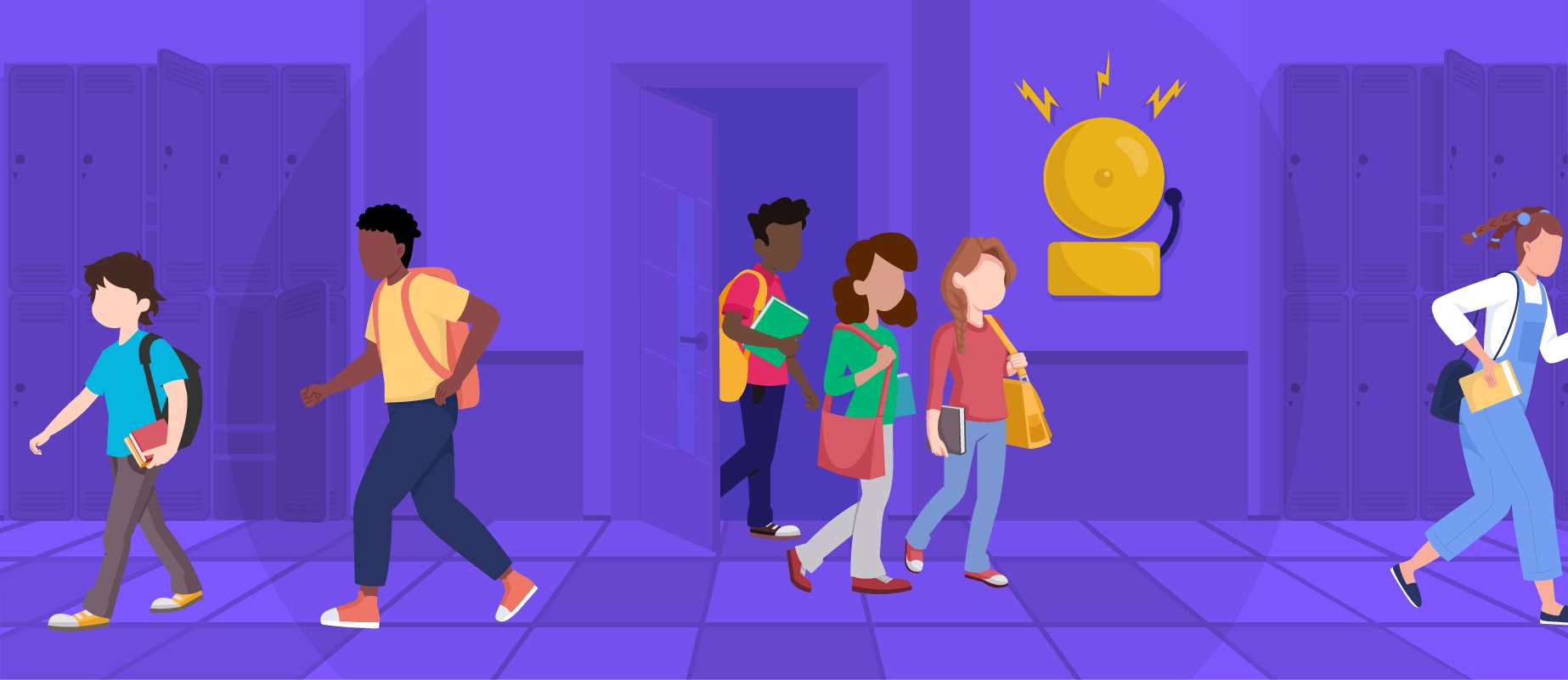In the News: Enhancing Safety in Schools Across Minnesota
Read the Story
SmartPass Co-Founders Listed on Forbes 30 Under 30
Read the Story

Lee Moskowitz
.avif)

Student success and well-being are core motivations for the work teachers and school staff do each day. Along with facts and figures, fostering a positive school culture and strong community relationships are big parts of what make that possible. It gives students the foundation they need to dive into the deeper concepts and meaningful skills that make a life-long impact. Getting this right looks different for each school community, so it’s worth taking the time to explore what makes it possible.
In honor of National Assistant Principal Week, we asked Assistant Principals throughout the United States to share positive school culture examples and their tips for building a strong school community. We were blown away by the amazing responses! Overall, we received over 60 responses, and we found clear patterns and trends.
According to Assistant Principals, the top ways to foster a positive school environment are:
Read on to learn more about fostering a positive school culture through relationship building, communication, visibility, leadership, and support. Plus, hear directly from assistant principals who share examples of a positive school learning environment.
Intentional actions add up and make an impact on the relationships with students, staff, and parents. It’s important for school leadership to take the time to connect with each group in the community and build real connections.
Making positive relationships the central part of your school is the key to creating a positive school culture. Staff wants to work for you, kids want to be there, and the community is strong and supportive when strong relationships are fostered each and every day.
-Annie Lovercamp, Assistant Principal at Warrensburg High School
Building relationships with your staff and students and finding little ways to celebrate them as individuals.
-Kriste Eaton, Assistant Principal of Attendance and Discipline at Cypress Palm Middle School
Create relationships. Be present and visible in the hallways, classrooms, and events and ensure that you are saying hi and building and maintaining relationships.
-Ailey Ruger, Assistant Principal at Monarch High School
Build genuine relationships with students, staff and parents. Everyone matters.
-Lori-Anne Wallen, Assistant Principal at Eagle Academy Bronx
Principals can start with small changes to daily routines, like greeting students by name in the hallway at a certain time of day, building in extra time to check in with their staff, and prioritizing parent outreach. Find time at the beginning of the school year to make it clear that relationships matter and give students, teachers, and parents clear ways to reach out when they need. We’ll touch on listening and visibility a lot in this article because they matter, especially here.
With the role teachers play in maintaining a supportive classroom environment, principals should take particular care in listening for ways to support them and make their work more effective and easier so they have the time and energy to pour into their relationships with students and families. Clear communication, flexible responsibilities and support, and the tools and technology to simplify their already overloaded to-do list can all go a long way.
Speaking of listening and communicating, let’s take a look at how that happens. Casual conversations that happen in the hallways and quick moments are as important as the official meetings and big milestones. In all of them, principals and teachers should focus on active listening, clear messaging, easy-to-remember expectations, and consistent transparency.
Listen to learn, don't listen to solve. Give every stakeholder a voice and a sense of value!
-Kirk Yudes, Assistant Principal & Athletic Director at Ladysmith Middle & High School
My top tip for fostering a positive school culture is encouraging open communication and collaboration among students, teachers, and staff.
-Rosetta Harrell, Assistant Principal at Kentwood High
Give praise, remember details, and show real engagement with what is happening in the school on a daily basis. Start the beginning of the year off strong communicating with students and their families. Give thoughtful and constructive feedback and be ready to receive the same. Lead by example to promote the importance of visibility and presence with things like taking the time to reach out to parents and families often, not just when something big happens.
Since principals can only be in one place at a time, the support they give to teachers, students, and parents so they can shape school culture is key. A supportive environment allows everyone to show up as best they can each day and makes it clear that they belong. It allows them to turn around and show support to others, too!
Availability, be present for your students and staff. If they see you and see that you are there for them, they will believe in you and the mission of your school. Be available!
-Joe Rorh, Assistant Principal at Noble Public School
Our robust RTI-B/PBIS program that is implemented for 9th, 10th, 11th, and 12th grade students. Additionally, we have schoolwide initiatives that support the reduction of chronic tardiness to class, academic failure, and chronic behavioral infractions.
-Dr. Mario Watkins, Assistant Principal at Cordova High School
By presenting myself in a positive way has a profound impact on shaping the school culture. By embodying optimism, kindness, inclusivity, and a growth mindset, I set an example for others to follow. My actions likely inspire my peers and create an environment where everyone feels valued and supported.
-Dianne Brown, Assistant Principal at Atlanta SMART Academy
Teachers can support students by being aware of their strengths and their needs, holding clear and age-appropriate expectations, encouraging them often, and offering help and resources when needed. They can also support parents by keeping them in the loop about school and student happenings and giving them opportunities to engage with the community. Parents can support teachers by following up with students on things at home or sharing important information from outside that help teachers understand what the student needs. Students can encourage each other and give positive feedback about group goals and behaviors. The layers all build on each other.
The need for safety and belonging is essential for students and everyone in the school community. Promoting equity, diversity, and inclusiveness and fostering a culture of respect and kindness in a school go a long way in any educational environment. Consciously creating spaces that meet the needs of all students as much as possible helps, allowing for lower stress, more engagement, and meeting a variety of needs and ways of interacting. This can be done through different learning tools and instruction methods, calm and inviting environments, and personal attention and support. Find ways to make it easy to access care and accommodations that are needed.
Promote inclusivity and diversity: Celebrate the unique backgrounds, talents, and perspectives of all members of the school community. Create opportunities for students to learn about and appreciate diversity through curriculum, events, and activities.
-Armand Peterson, Assistant Principal at Prince George's County Public Schools (PGCPS)
Part of the power of listening is the chance to hear what makes each student, teacher, and community member unique and being able to meet their daily needs and goals better because of that information. Give them time and space to share those things with their peers as well and find time to celebrate group and individual accomplishments. Take time for the deeper conversations that surround these topics, too, so that students, teachers, administration, and parents are equipped with knowledge and skills to advocate, empathize, and understand.
Integrity and trust are non-negotiables in any healthy relationship, and that’s no different when growing a positive school culture. When it starts in the leadership roles, it creates a sense of safety that allows everyone else to be more genuine and transparent, as well. It adds more openness to conversations and gives a structure for other values to grow.
Fostering positive school culture happens in the little, intentional moments as well as in the overall core values of a building. The poignant effort to check in with staff regularly, be a presence in the hallways, continually popping into classrooms, and getting to know the likes of individuals all contribute to a feeling of family. Additionally, having agreed upon core values allows common language among staff to use with students. This creates a cohesive building culture that aligns to real-world characteristics.
-Lindsey Namanny, Assistant Principal at North Valley High School
Communication and transparency with all stakeholders.
-Fernado Gonzalez, Assistant Principal at West Campus High School
In a world of social media, it’s easy to think posting often enough is being transparent but it’s more than that. School leadership, teachers, and staff need to find people where they are in the community as well, and make sure they’re sharing the right information with each group consistently. A commitment to transparency that’s prioritized and well-executed can be a major catalyst for a whole new school culture.
The need to feel safe and secure isn’t a new or surprising concept for child development and learning, but it’s an adapting one. The core needs are all there. Students need to know there are adults who care about them, know them, and are available when they need them. Bullying should be prevented and addressed. Positive behavioral interventions and support can go a long way in building a safe environment for everyone. It’s important for students to have autonomy within their daily structure, paired with clear expectations and easy-to-understand processes.
Intentionally create safe spaces for students outside of the academic classroom to share their identity.
-Jane Jung, Assistant Principal at Ellen Fletcher
Safety in crowded spaces. All teachers, aides, administrators, and other personnel are visible.
-Kathleen O'Farrell, Assistant Principal at NYC DOE
Being supportive of all students while maintaining safety of the school. With that look toward whole school restorative practices.
-Paula Brault, Assistant Principal at Mohawk Trail Regional School
Basics like keeping up with what students need, making sure they are in their best environment and with the right people at the right times, and even being able to account for the location of each student in an emergency are essential. Make sure to take time to set the stage for these things before there’s a crisis, too. Shared responsibility and the right systems prevent a lot of issues, while tools and well-practiced emergency procedures help in those stressful moments.
The expectation of consistency and fairness play a big role in building feelings of safety and belonging, as well. The first part of this process comes from a joint effort for creating and communicating policies and expectations. Keep things simple and clear and make sure everyone in the community has a chance to share their experiences, give input, and ask questions.
Always remain firm, fair and consistent.
-Penny Monroe, Assistant Principal at Overhills High School
Building relationships with students on a fair, consistent, and firm foundation.
-Kayla Brown, Assistant Principal at Arkansas Middle School
Ensure behavioral rewards and consequences are administered consistently, appropriately, and in a timely manner.
-Alan Androski, Assistant Principal at James Madison Preparatory High School
The second part of the process is in the application. While remaining flexible to changing situations and a variety of needs, principals and school leadership should provide the fairness and structure to make day-to-day support and expectations reliable and predictable. Don’t forget the power of positive reinforcement and a consistent presence, either. Feedback and guidance is more effective for teachers, students, and families when it’s holistic, personalized, and doesn’t wait for the official moments to show up.
One way to support school community engagement, student growth, and meaningful connections is to make the most of positive reinforcement.
We make intentional choices to celebrate students with positive measures and see the good in every way we can. We focus on fostering a culture of high expectations, reinforcing those expectations with positive narration in our classrooms, hallways, and building spaces, and create events where students who are culture leaders can be seen and recognized as often as possible. These moves have helped us shift away from the difficult moments that can impact education and instead, move our focus to see and be the good in our community.
-Rachel Voris, Assistant Principal at Atlas Preparatory School
Even if it just gave a sense of accomplishment and spurred a few extra smiles, it would be worth the time and effort. However, it’s much more impactful than that. No big goals or tough paths can be handled for too long without some encouragement along the way. Principals, teachers, students, parents, and all other community members need the chance to celebrate together, show appreciation for hard work and the desire to grow, and feel like their community see who they are and what they do.
Principals, Assistant Principals, Vice Principals, and other administrators and leaders carry a big piece of the work to shape their school culture and create a conducive learning environment. Intentional review of current systems and results, gathering feedback and insights from community members, investing in relationship building, better communication, offering support, and making a commitment to inclusivity are all part of that leadership role. Taking the time to be present, engaged, and available isn’t easy, but it has so much to offer.
For all of the efforts you have put into prioritizing positivity, transparency, safety, and community engagement, keep it up! Find the tools like SmartPass that help make it more effective and efficient. It helps students show up each day and be accountable, engaged, and safe. The support it gives teachers and the worry and workload it takes off their plate helps them feel heard and makes their lives easier, too. As you build your positive school culture strategy, consider making SmartPass part of your toolkit!



